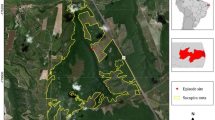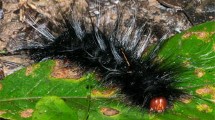Abstract
We observed two capuchin monkeys (Cebus capucinus) feeding on hermit crabs (Coenobita compressus) on the coast, and the tactics they used to extract this well-protected prey. The observations took place during the dry season at Playa Escondida beach, Puntarenas, Costa Rica. The capuchins descended from trees at the back edge of the beach to capture passing hermit crabs. Both capuchins extracted the hermit crabs from their protective shells by holding the shell with one hand and pulling the crab out with the other. Even though this was accomplished within seconds, the extraction of hermit crabs from their shells did not appear to be a straightforward task. Once the capuchins succeeded in pulling the crabs out of their shells, they consumed the soft abdomen and discarded the rest of the crab's body. To our knowledge, the consumption of hermit crabs has not been previously reported for any capuchin monkey (Cebus or Sapajus). Our observations provide a new example of extractive foraging by capuchins, and thus an additional natural context for which fine motor skills (which are highly developed in capuchins) are necessary.

Similar content being viewed by others
References
Alfaro JWL, Silva JDSE, Rylands AB (2012) How different are robust and gracile capuchin monkeys? An argument for the use of Sapajus and Cebus. Am J Primatol 74:273–286
Bolnick DI, Svanback R, Fordyce JA, Yang LH, Davis JM, Hulsey CD, Forister ML (2003) The ecology of individuals: incidence and implications of individual specialization. Am Nat 161:1–28
Campbell J (2013) White-faced capuchins (Cebus capucinus) of Cahuita National Park, Costa Rica: human foods and human interactions. Dissertation, Iowa State University
Carnegie SD, Fedigan LM, Melin AD (2011) Reproductive seasonality in female capuchins (Cebus capucinus) in Santa Rosa (Área de Conservación Guanacaste), Costa Rica. Int J Primatol 32:1076–1090
Chapman CA, Fedigan LM (1990) Dietary differences between neighboring Cebus capucinus groups: local traditions, food availability or responses to food profitability? Folia Primatol 54:177–186
Cutrim FHR (2013) Padrão comportamental e uso de ferramentas em macacos-prego (Sapajus libidinosus) residentes em manguezal. Dissertation, Universidade de São Paulo
Fedigan LM (1990) Vertebrate predation in Cebus capucinus: meat eating in a Neotropical monkey. Folia Primatol 54:196–205
Fernandes ME (1991) Tool use and predation of oysters (Crassostrea rhizophorae) by the tufted capuchin, Cebus apella apella, in brackish water mangrove swamp. Primates 32:529–531
Fragaszy DM, Visalberghi E, Fedigan LM (2004) the complete capuchin: the biology of the genus Cebus. Cambridge University Press, New York
Freese CH (1983) Cebus capucinus (Mono cara blanca, white-faced capuchin). In: Janzen DH (ed) Costa Rican natural history. The University of Chicago Press, Chicago, pp 458–460
Freese CH, Oppenheimer JR (1981) The capuchin monkey, genus Cebus. In: Coimbra-Filho AF, Mittermeier RA (eds) Ecology and behavior of neotropical primates. Academia Brasileira de Ciências, Rio de Janeiro, pp 331–390
Gumert MD, Malaivijitnond S (2012) Marine prey processed with stone tools by Burmese long-tailed macaques (Macaca fascicularis aurea) in intertidal habitats. Am J Phys Anthropol 149:447–457
Hazlett BA (1981) The behavioral ecology of Hermit Crabs. Ann Rev Ecol Syst 12:1–22
Janson CH, Boinski S (1992) Morphological and behavioral adaptations for foraging in generalist primates: the case of the cebines. Am J Phys Anthropol 88:483–498
Jiménez Q, Carrillo E (2016) The Central Pacific seasonal forests of Puntarenas and the Central Valley. In: Kappelle M (ed) Costa Rican ecosystems. The University of Chicago Press, Chicago, pp 345–411
McKinney T (2011) The effects of provisioning and crop-raiding on the diet and foraging activities of human-commensal white-faced capuchins (Cebus capucinus). Am J Primatol 73:439–448
Moura AC, Lee P (2004) Capuchin stone tool use in Caatinga dry forest. Science 306:1909
Ottoni EB, Izar P (2008) Capuchin monkey tool use: overview and implications. Evol Anthropol 17:171–178
Panger MA, Perry S, Rose L, Gros-Louis J, Vogel E, Mackinnon KC, Baker M (2002) Cross-site differences in foraging behavior of white-faced capuchins (Cebus capucinus). Am J Phys Anthropol 119:52–66
Port-Carvalho M, Ferrari SF, Magalhães C (2004) Predation of crabs by tufted capuchins (Cebus apella) in eastern Amazonia. Folia Primatol 75:154–156
Robinson JG (1986) Seasonal variation in use of time and space by the wedge-capped capuchin monkey, Cebus olivaceus: implications for foraging theory. Smithson Contrib Zool 431:1–60
Solano-Quintero J, Villalobos-Flores R (2001) Physiographic aspects applied to a regionalized climate geographical sketch of Costa Rica. Top Meteor Oceanog 8:26–39 (in Spanish with English summary)
Visalberghi E, Trinca L (1989) Tool use in capuchin monkeys: distinguishing between performing and understanding. Primates 30:511–521
Acknowledgments
We would like to thank José Manuel Agüero and his family for their hospitality in Playa Escondida. Rita Vargas kindly identified the hermit crabs, and Mark Wainwright provided valuable suggestions to a previous version of the manuscript. We would like to dedicate this small contribution to Arnoldo Soley Soler, since we were celebrating his 70th birthday at the time the observations were made.
Author information
Authors and Affiliations
Corresponding author
About this article
Cite this article
Soley, F.G., Chacón, I.S. & Soley-Guardia, M. Extraction of hermit crabs from their shells by white-faced capuchin monkeys (Cebus capucinus). Primates 58, 25–29 (2017). https://doi.org/10.1007/s10329-016-0576-5
Received:
Accepted:
Published:
Issue Date:
DOI: https://doi.org/10.1007/s10329-016-0576-5




